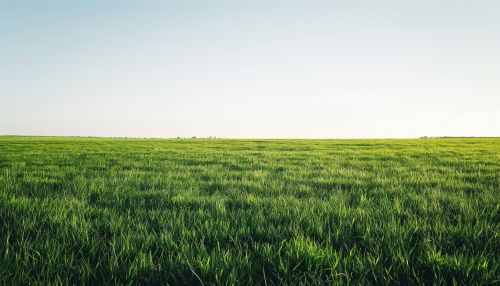Grassland ecosystems
Introduction
Grassland ecosystems are a type of terrestrial biome characterized by the dominance of grasses and other herbaceous (non-woody) plants. They cover about 25% of the Earth's land surface and are found on every continent except Antarctica. Grasslands are vital for human survival and well-being, providing essential ecosystem services such as food production, water regulation, and carbon sequestration.
Types of Grasslands
Grassland ecosystems can be broadly classified into two types: tropical grasslands (also known as savannas) and temperate grasslands.
Tropical Grasslands
Tropical grasslands, or savannas, are found in regions near the equator. These ecosystems are characterized by a warm climate with seasonal rainfall. The grasses in these areas are tall and coarse, and there are often scattered trees and shrubs. The savannas of Africa, for example, are home to a rich diversity of wildlife, including large mammals such as elephants, zebras, and various species of big cats.
Temperate Grasslands
Temperate grasslands are found in colder climate regions, and they often have a higher density of wildflower species compared to tropical grasslands. These ecosystems are characterized by a climate with cold winters and warm summers. The grasses in these areas are usually shorter and finer than those in tropical grasslands. Examples of temperate grasslands include the prairies of North America, the pampas of South America, the steppes of Eurasia, and the veld of South Africa.


Biodiversity
Grassland ecosystems are rich in biodiversity, hosting a wide variety of plant and animal species. They are particularly known for their diverse array of grass species, with some grasslands hosting up to 60 different species in a single square meter.
Flora
The dominant vegetation in grassland ecosystems is, unsurprisingly, grass. However, these ecosystems also host a variety of other plant species, including wildflowers and, in the case of savannas, scattered trees and shrubs. The specific species present in a grassland ecosystem depend on a variety of factors, including the climate, soil type, and fire regime.
Fauna
Grassland ecosystems are also home to a diverse array of animal species. These include large grazers, such as bison and antelope; smaller herbivores, such as rabbits and mice; and a variety of predators, such as wolves and birds of prey. Grasslands also host a wide variety of invertebrates, including insects and spiders, many of which play crucial roles in the ecosystem as pollinators and decomposers.
Ecosystem Services
Grassland ecosystems provide a range of ecosystem services that are essential for human well-being. These include provisioning services, such as food and raw materials; regulating services, such as climate regulation and water purification; and cultural services, such as recreational opportunities and aesthetic value.
Provisioning Services
Grasslands are important for agriculture, providing grazing land for livestock and fertile soil for growing crops. They also provide raw materials such as hay for animal feed and grass for thatching roofs.
Regulating Services
Grasslands play a crucial role in climate regulation by sequestering carbon, which helps to mitigate climate change. They also contribute to water regulation by absorbing rainfall and reducing surface runoff, which can help to prevent flooding and erosion.
Cultural Services
Grasslands also have significant cultural value. They provide opportunities for recreational activities such as hiking and birdwatching, and they have been the inspiration for numerous works of art, literature, and music. In addition, many indigenous cultures have deep spiritual connections to grasslands and the species that inhabit them.
Threats to Grasslands
Despite their importance, grassland ecosystems around the world are under threat from a variety of factors. These include land conversion for agriculture, urban development, climate change, and invasive species.
Land Conversion
One of the biggest threats to grasslands is land conversion for agriculture. As the human population continues to grow, there is increasing pressure to convert grasslands into farmland for growing crops or raising livestock. This not only leads to the loss of grassland habitat, but it can also result in soil degradation and a loss of biodiversity.
Urban Development
Urban development is another major threat to grasslands. As cities and towns expand, grasslands are often destroyed to make way for new buildings and roads. This can lead to habitat fragmentation, which can have negative impacts on grassland wildlife.
Climate Change
Climate change is also a significant threat to grasslands. Changes in temperature and precipitation patterns can affect the growth and survival of grassland plants and animals. In addition, climate change can lead to an increase in the frequency and intensity of wildfires, which can have devastating effects on grassland ecosystems.
Invasive Species
Invasive species are another major threat to grasslands. These are non-native species that have been introduced to a new area, either intentionally or accidentally, and that cause harm to the native species and ecosystems. In grasslands, invasive species can outcompete native plants for resources, alter habitat conditions, and disrupt ecosystem processes.
Conservation
Given the importance of grassland ecosystems and the threats they face, conservation efforts are crucial. These can involve a range of strategies, from protected area establishment and sustainable land management practices to public education and policy development.
Protected Areas
One of the most effective ways to conserve grasslands is through the establishment of protected areas. These are areas of land that are set aside for the conservation of wildlife and habitats, and they can play a crucial role in preserving grassland ecosystems.
Sustainable Land Management
Sustainable land management practices can also help to conserve grasslands. These can include strategies such as rotational grazing, which involves moving livestock from one area to another to prevent overgrazing; and controlled burning, which can help to maintain the health and diversity of the grassland.
Education and Policy
Public education and policy development are also important for grassland conservation. By educating the public about the importance of grasslands and the threats they face, it is possible to generate support for conservation efforts. Similarly, by developing and implementing policies that protect grasslands and promote sustainable land use, it is possible to reduce the impacts of threats such as land conversion and climate change.
